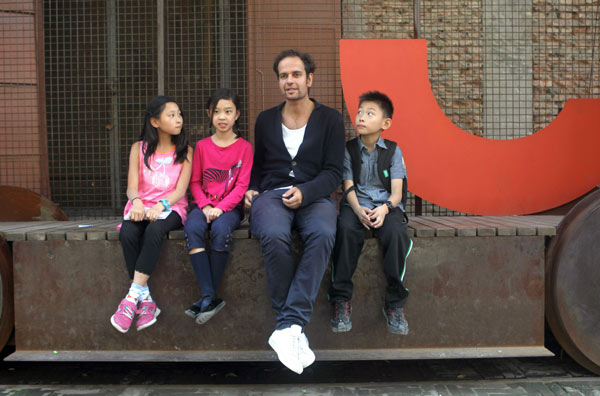Progressive artwork questions visitors' values
Updated: 2013-10-26 08:04
By Chen Nan (China Daily)
|
||||||||
|
 Tino Sehgal sits on the gate of UCCA with children, who visit his exhibition that continues in Beijing through Nov 17. Zou Hong / China Daily |
"Can you tell me what progress is?"
This is a question you may be asked by a young girl at the exhibition hall of Ullens Center for Contemporary Art in Beijing. If you give an answer, you may find yourself being approached by other people until you realize you are speaking with an elderly performer, having traveled through zigzagging laneways. You have actually become part of UCCA's latest exhibition by British-German artist Tino Sehgal.
The exhibition is the artist's largest presentation in Asia to date, and according to Biljana Ciric, a Shanghai-based independent curator, the show only occurs in the moment a conversation happens between volunteers working for the artist - Sehgal calls them "interpreters" - and the visitors.
"This is not a conventional exhibition if you define an exhibition as something with tangible objects," says Ciric. "But this is what the artist does. He is not a performance artist. He creates situations in exhibitions, which are called 'constructed situations'."
Ciric says the questions take on a particular resonance in China and are aimed at having visitors reflect upon their desires and the aesthetics of their daily lives.
"The result is a series of exchanges that touch upon philosophical, political and economic issues, variously questioning the social conventions that support our daily existence," she says. "China is undergoing a huge transformation in its market economy and everyone is involved in it. Though the concept is abstract, people have their understanding."
When Ciric brought Sehgal's work to China for the first time in Shanghai last year, Sehgal did not attend. During the exhibition in Beijing, he quietly walks around the space, observing the interaction between the interpreters and the visitors.
"I set up these virtual games with relatively simple rules in which a group of individuals has to work together," explains the 36-year-old artist about the concept of "constructed situation", for which he is acclaimed. "I feel like a coach here."
"Everyone in the space walks through time. I want to put you in that space, which is not everyday motivation but individualized activation," he says.
Sehgal, who was born in London and has lived in Berlin for 18 years, says he thinks about each piece for a long time.
"Sehgal's preparation for his exhibitions is long and intense; what looks to be improvised is usually the result of careful planning," Ciric says.
His departure from traditional exhibition format might come from his lack of formal training at art school. He studied political economy and dance at Humboldt University in Berlin and later danced with companies headed by French experimental choreographers Jerome Bel and Xavier Le Roy. He once said that he wants dance to be as serious as art instead of always being connected to theater and film.
His first piece, Instead of Allowing Something to Rise Up to Your Face, Dancing Bruce and Dan and Other Things in 2000, drew heavily from his dance background. It features a single dancer writhing on the floor and incorporating poses from videos by artists Dan Graham and Bruce Nauman.
In 2007, his work Kiss, which saw a couple continuously enact a sequence of specific kisses from famous works of art, was exhibited at the Museum of Contemporary Art, Chicago, his first work in an American museum.
As a phenomenon in art circles, Sehgal was the youngest person ever to represent Germany in the Venice Biennale in 2005, and he won the Golden Lion award at the 2013 Venice Biennale. He has also been selected as one of four finalists for the Turner Prize; the winner will be announced in December.

 Post-baby Duchess
Post-baby Duchess
 Victoria Beckham S/S 2014 presented during NYFW
Victoria Beckham S/S 2014 presented during NYFW
 'Despicable' minions upset Depp's 'Lone Ranger' at box office
'Despicable' minions upset Depp's 'Lone Ranger' at box office
 'Taken 2' grabs movie box office crown
'Taken 2' grabs movie box office crown
 Rihanna's 'Diamonds' tops UK pop chart
Rihanna's 'Diamonds' tops UK pop chart
 Fans get look at vintage Rolling Stones
Fans get look at vintage Rolling Stones
 Celebrities attend Power of Women event
Celebrities attend Power of Women event
 Ang Lee breaks 'every rule' to make unlikely new Life of Pi film
Ang Lee breaks 'every rule' to make unlikely new Life of Pi film
Most Viewed
Editor's Picks

|

|

|

|

|

|
Today's Top News
US sets Dec 10-11 hearing on Asiana plane crash
Forum call on mutual responsibilities
NQ Mobile hits back at short-seller after US stock plunge
Combating air pollution may hurt water supplies: Experts
Forum to guide China and Japan
Xi stresses ties with neighbors
China, EU to build trust and create fresh co-op
Health care site needs fixes
US Weekly

|

|






